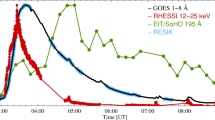Abstract
It is shown that the far-ultraviolet radiation (shorter than 2000 Å) discovered by ANS observations in the few T Tauri-type stars does not have any relation to the two-photon emission of hydrogen, as suggested by some authors. This is obtained from the observational data of the numerical values of the ratioQ *(2q)/Q *(β) for these stars, whereQ *(2q) is the complete number of the observed 2q-photons andQ *(β) is the number of observedHβ-photons. The observational values ofQ *(2q)/Q *(β) for four T Tauri-type stars turned out to be in the region of 20–90, while the theoretical value of this relation is 6. Hence, the observed fluxes in the region λ<2000 Å are 3–15 times larger than the theoretically expected values.
The emission discovered in the region λ<2000 Å is of non-thermal origin, and can be identified with high probability with thetransition radiation. The latter originates as a result of the electromagnetic interaction of so-called fast electrons (E∼1.5 MeV) with dust particles in the gas-dust clouds surrounding these stars. The theoretical spectral curves of the transition radiation, for a few values of the plasma frequency ω0 for the dust particles, are calculated taking into account also the self-absorption effect of the radiation in the cloud and the absorption in the interstellar medium. Qualitatively, these curves (Figures 2, 3 and 4) are in good accord with the observed spectral distribution curves for the T Tauri-type stars (Figure 1). In particular, in both cases a minimum of radiation flux occurs near to 2200 Å, and a maximum near 1800 Å.
The starting point of our analysis has been the concept of the identity of the processes, non-thermal and non-stationary in character, taking place at the time of the flare phenomenon of UV Cet-type stars in one case, and at the generation of continuous emission and the excitation of the emission lines in T Tauri-type stars on the other. In the latter case, the T Tauri-type stars can be regarded aspermanently flaring stars, with a very high frequency of flare events.
Similar content being viewed by others
References
Bless, R. C. and Savage, B. D.: 1972,Astrophys. J. 171, 293.
Boer, K. S. de: 1977,Astron. Astrophys. 61, 605.
Garibian, G. M.: 1957,JETP 33, 1403.
Gerola, H. and Panagia, N.: 1968,Astrophys. Space Sci. 2, 285.
Gurzadyan, G. A.: 1969,Planetary Nebulae, Gordon and Breach, N.Y.
Gurzadyan, G. A.: 1972,Astron. Astrophys. 20, 145.
Gurzadyan, G. A.: 1973a,Flare Stars (in Russian), Nauka, Moscow.
Gurzadyan, G. A.: 1973b,Astron. Astrophys. 28, 147.
Gurzadyan, G. A.: 1975,Astrofizika 11, 531.
Herbig, G. H.: 1962, in Z. Kopal (ed.),Advances in Astron. Astrophys. Academic Press, New York,1, 47.
Herbig, G. H.: 1970,Mem. Soc. Roy. Sci. Liège 79, 13.
Mendoza, E. E.: 1968,Astrophys. J. 151, 977.
Nandy, N., Thompson, G. I., Jamar, G., Monfils, A., and Wilson, R.: 1975,Astron. Astrophys. 44, 195.
Salmanov, I. R.: 1975, ‘Spectrophotometric and Photoelectric Investigation of T Tauri-type Stars’, Thesis, Shemacha Astrophysical Observatory.
Author information
Authors and Affiliations
Rights and permissions
About this article
Cite this article
Gurzadyan, G.A. On the far-ultraviolet radiation of the T Tauri-type stars. Astrophys Space Sci 62, 67–77 (1979). https://doi.org/10.1007/BF00643904
Received:
Issue Date:
DOI: https://doi.org/10.1007/BF00643904



